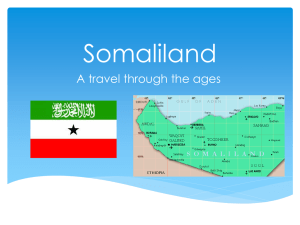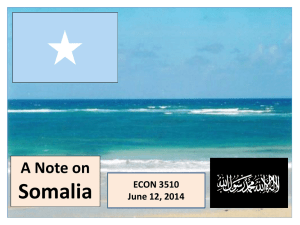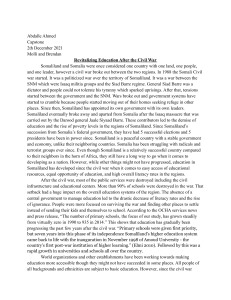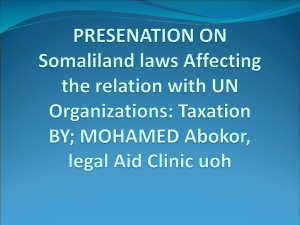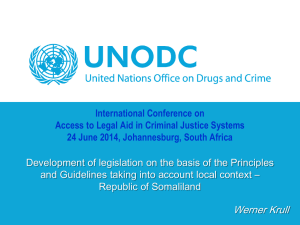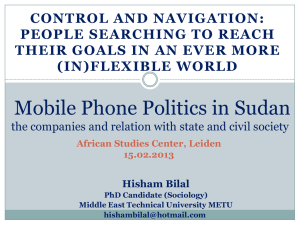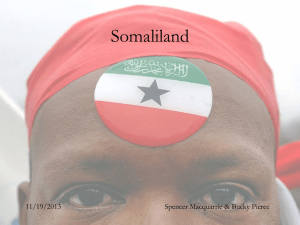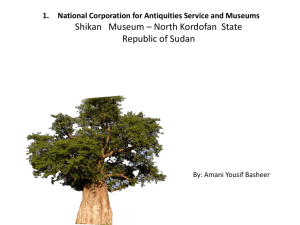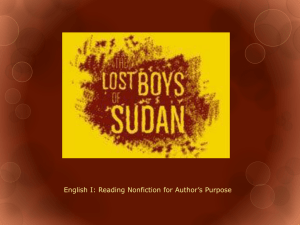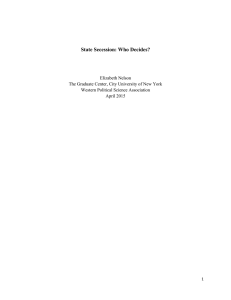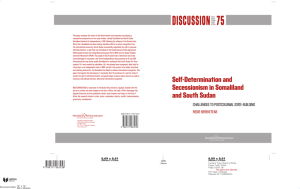dezintegrační procesy v oblasti afrického rohu: srovnávací analýza
advertisement
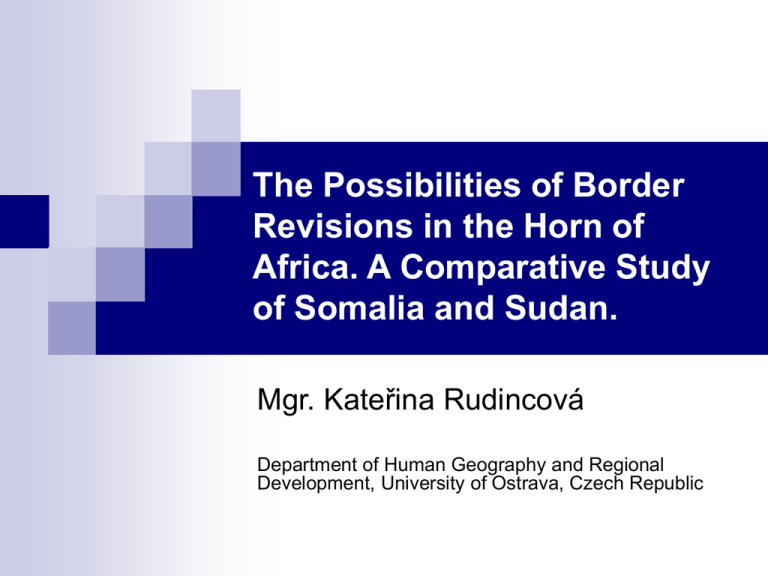
The Possibilities of Border Revisions in the Horn of Africa. A Comparative Study of Somalia and Sudan. Mgr. Kateřina Rudincová Department of Human Geography and Regional Development, University of Ostrava, Czech Republic Methodology Comparation of concepts of right to selfdetermination and uti possidetis Application on the cases of Somalia (Somaliland) and Sudan (separation of South Sudan) Semi-structured interviews at the Commission of AU, Addis Ababa 2010 and 2011 Interview with former foreign minister of Somaliland in 2010 Right to self-determination of peoples Right to self-determination of peoples – 14 points of President Wilson, UN Charter UN General Assembly – 1960 – Resolution 1514-XV: „all peoples have the right to self determination; by virtue of that right they freely determine their political status and freely pursue their economic, social and cultural development“ Right to self-determination stressed by the International Covenant on Economic, Social and Cultural Rights (1966) and International Covenant on Civil and Political Rights Concept of self-determination challenges the current state borders in Africa Uti possidetis OAU Charter – 1963 – concept of inviolability of borders inherited from the colonial past Paragraph 3, Article III: Member states declare their adherence to „Respect for the sovereignty and territorial integrity of each State and for its inalienable right to independence“ OAU supported emancipation of African territories within already existing borders OAU Conference in Cairo – 1964 – Resolution 16(1): „all Member States pledge themselves to respect the borders existing on their achievement of national independence“ → principle of the right of African peoples to selfdetermination has been replaced by the doctrine of inviolability of African borders Border issues in the Horn of Africa Different secessionist units in the Horn of Africa Southern Sudan – recognized by AU and international community, even though its existence violates the principle of uti possidetis De facto state of Somaliland – failed to achieve international recognition, althought it meets three Montevideo criteria for independent existence – population, territory and state power Southern Sudan Whole Sudan administered as British – Egyptian condominium „Crises of national identity“ in Southern Sudan (F. Deng 2010) British politics in Sudan: de facto separation of „African“ south from the „Arab“ north – barrier against the spread of Islam (Christian missions, English, indirect administration) → South Sudan went through different political and historical development Civil War in Sudan 1956 – independence of Sudan – inherited colonial boundaries, Arab – Islamic state, marginalization of southern Sudanese ethnics → civil war 1972 – peace agreement in Addis Ababa, regional authonomy 1983 – Jafar Nimairi declared Sudan an Islamic state, introduced Sharia Opposition groups in Southern Sudan: Demand of emancipation of Southern nations - SPLM Demand of independence – Anyanya II, SSIM Peace negotiations, significant role of the regional powers and organizations in peace process (Nigeria, IGAD) Regional dimension: Kenya x Egypt, Ethiopia - ambivalent approach 9.1.2005 – conclusion of the agreement between SPLM and Sudanese government - CPA Somaliland former British protectorate x Southern Somalia – Italian colony → different historical and political development 26th June 1960 – independence of Somaliland, recognized by 35 states 1st July 1960 – uniting with Southern Somalia Since 1969 – oppresive regime of Siad Barre Decalaration of independence – 18th May 1991 International Recognition of Somaliland? Arguments of political reprezentation of Somaliland: Territory of the Republic of Somaliland covers the same area as that of the former Somaliland Protectorate Requires the preservation of principle of uti possidetis: „for Somaliland, independence was on 26 June 1960 and not on 1 July 1960 when it entered into a voluntary union with Somalia and the fact that the OAU Declaration was made in 1963 does not affect the application of the doctrine“ referendum of unity was manipulated; Atto di Unione differed from that adopted in Somaliland The right to self-determination was not guaranteed fot northern clans, their human right have been violated Independent existence would contribute to economic development and could possibly affect the development of whole region AU perspective Somaliland has never challenged the act of unity with Southern Somalia Recognize TFG as an representative of united Somalia The agreement between Somaliland and Transitional Federal Government of Somalia has not been achieved Unilateral secession is not acceptable People of Somaliland perceived as a part of Somali nation Observatory status at AU is not possible Somaliland should try to gain support from the African states (but complicated regional politics) Somaliland vs. Southern Sudan Southern Sudan: Turned on its side attention of international community – prolonged civil war International Recognition of Southern Sudan – attempts to achieve stability in the region Somaliland: Long-term peace, creation of institutions, democratic elections, government successfully controls claimed territory Clans of Somaliland are still perceived to be the part of Somali nation Support of African states is crutial → right to self-determination of the peoples and principle of uti possidetis are used ambivalently Thank you for your attention.

